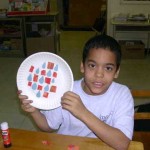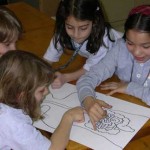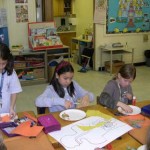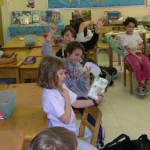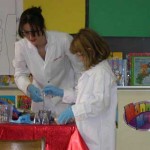Digestive Enzymes
October 6, 2011 in Protein
Catalyzed by the help of university students Genevieve Collett (Master Art Education, Concordia U.) and Tanya Godina (M.Sc., U. Montréal) the Molecules of Life Project (MLP) had its Montréal debut with the “Proteins of Life” in Mrs Shuster’s third grade class at École F.A.C.E. School on Monday, the 21st of January 2008.
Gen and Tanya led a discussion that covered nutrition, digestion and the featured proteins of life, the “digestive enzymes”.
After presenting laboratory safety, Tanya helped a student volunteer perform the starch iodine test in which an iodine / potassium iodide solution in water was added to a ground up cracker in water producing a dark blue-black solution which garnered everyone’s attention. In contrast, in a second flask into which the students added their own salivary juices to the cracker water mix, only a pale yellow color was produced by the iodine solution. A discussion followed in which the digestion of carbohydrates into simpler sugars in the mouth was discussed and the enzyme salivary amylase, which breaks starch (a polysaccharide) down to maltose (a disaccharide) was introduced.
Focusing on nutrition, Gen asked the students to draw pictures of their favorite foods which they later sorted into the four food groups (grains, fruits and vegetables, meats, and dairy).
Packaging materials from various foods were then distributed and the students were asked to read the Nutrition Facts and to separate the foods into two groups: those that had more carbohydrates and those which contained more protein.
Tanya and Gen then led the students through the digestive system from the mouth into the stomach, where another enzyme, pepsin, helps to break proteins up into their building blocks called amino acids. Then into the small intestine where the amino acids, sugars and other nutrients are absorbed, and into the large intestine in which water is absorbed, before the remaining waste is excreted.
Behaving like digestive enzymes, the students were asked to cut up their food pictures into squares if the food contained more proteins or triangles if the food contained more carbohydrate. With the pieces, and others supplied for water, the students then made mosaics, representative of healthy cells fed a balanced nutritional diet.
WIth six more proteins scheduled this year, we thanked team digestive enzyme for a well balanced meal of MLP creativity at FACE.
For more information see:
Starch Iodine Test: www.elmhurst.edu/~chm/vchembook/548starchiodine.html
The digestive system: http://faculty.clintoncc.suny.edu/faculty/michael.gregory/files/Bio%20102/Bio%20102%20lectures/Digestive%20System/digestive%20system.htm
The Four Food Groups: www.jewishveg.com/schwartz/ffgroups.html









